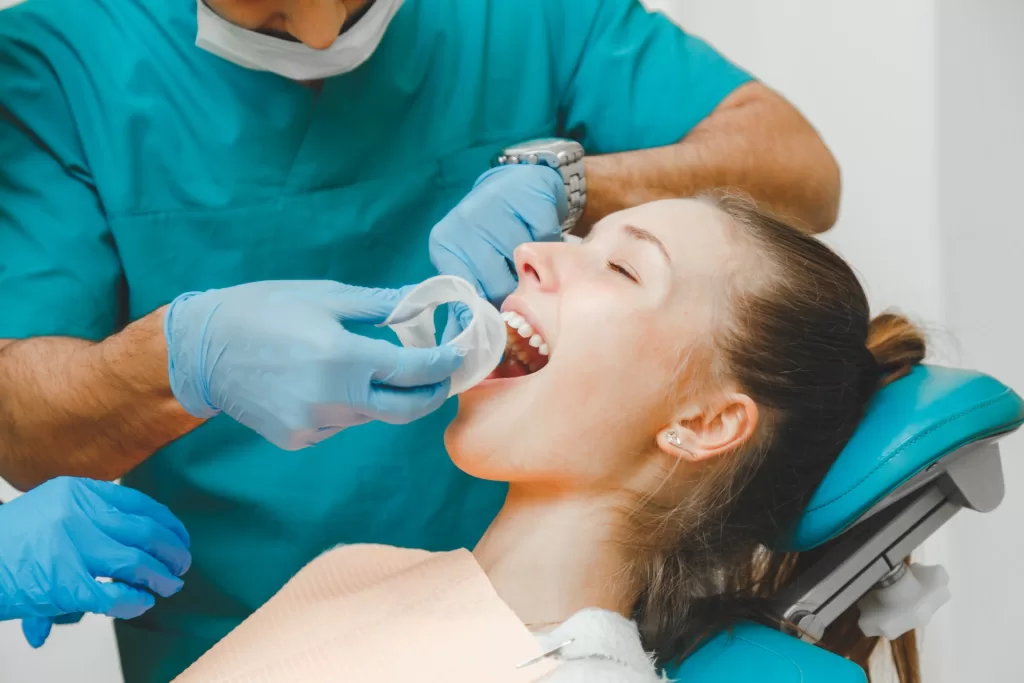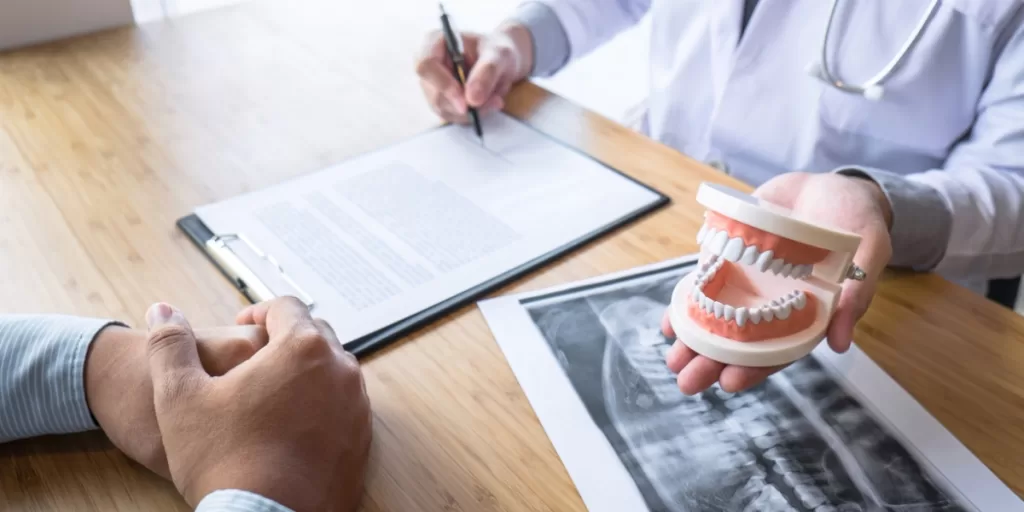Picture yourself sitting in a dental chair, racing heart as you hear the soft whir of a drill. If this sounds familiar, don’t worry—you’re not alone: studies reveal that almost 58.7% of adults are anxious about oral surgery, with many mentioning fears of pain or discomfort. But the truth is this: with modern oral anesthesia, painful procedures are virtually a thing of the past.
Here at Ridge Oral Surgery, we’ve witnessed the impact of sophisticated anesthesia methods in soothing nerves and providing uneventful procedures. Throughout this guide, we will guide you through everything you need to know about oral anesthesia, including the science behind it and how our staff keeps your safety at the top of their priority list. Let’s transform that nervousness into confidence!
What Is Oral Anesthesia?
Oral anesthesia is used to block pain sensations during dental and oral surgery procedures. It anesthetizes part of your mouth so that you don’t sense pain when work is being accomplished. This type of anesthesia has nothing to do with swallowing tablets—despite its name, it is referred to as a form of anesthesia that is given for oral (mouth) surgery.
Now, let’s dispel a frequent confusion: oral anesthesia is not the same as general anesthesia. General anesthesia knocks you out totally—you’re unconscious. However, oral anesthesia generally means local anesthesia or sedation that keeps you alert but relaxed and pain-free.
A common myth is that all forms of anesthesia cause unconsciousness, which isn’t the case. Most oral surgeries employ local anesthetics such as lidocaine, which leaves you completely conscious yet prevents pain in the area where surgery is to take place.
By knowing this difference, anxiety and fear are assuaged and expectations managed. Patients, then, are empowered to make a knowledgeable decision about the ideal type of anesthesia for their surgery.
Types of Anesthesia in Oral Surgery
We customize the kind of anesthesia in oral surgery depending on the procedure, your history, and your comfort. These are the four primary types we employ:
Local Anesthesia
This is the most used and entails numbing only the area to be treated. Lidocaine is typically employed, and you’ll be wide awake and alert but won’t feel anything. It’s ideal for small procedures such as simple extractions or fillings.
IV Sedation (Moderate Sedation)
Given in a vein, this provides relaxation to a greater extent. You’re awake from a technical point of view, but may not even recall much afterward. It is usually applied when impacted wisdom teeth or dental implants are to be removed.
General Anesthesia (Deep Sedation)
Only apply for complicated or long procedures, as this puts you to sleep. You’re unconscious and regularly monitored. This is typically reserved for jaw surgeries or patients with severe dental anxiety.
Nitrous Oxide (Laughing Gas)
This light sedative is breathed in through a mask. It acts rapidly, has a quick recovery, and keeps you relaxed. You’ll remain awake and responsive but less nervous. Each one is used for a different reason, and our task is to pair you with the safest and most effective one.
How Anesthesia in Oral Surgery Is Administered

Before we even begin any procedure, we start with a thorough evaluation. That involves going over your medical history, medications, allergies, and past experiences with anesthesia. We need to identify any red flags before proceeding.
The anesthetic is introduced during the treatment in different ways—injection, IV line, or inhalation, depending upon the type. We apply a topically numbing gel prior to injections to ensure minimal discomfort. For IV sedation or general anesthesia, we insert a little line into your vein, which is usually in your arm or hand.
During the procedure, we keep your vital signs close at hand—heart rate, oxygen saturation, blood pressure, and breathing—and monitor them continuously with FDA-cleared equipment. This keeps you safe at every turn. Reversal medication and emergency systems are also ready, although in our experience, it is very uncommon to need to use them.
Safety First: Is Anesthesia for Oral Surgery Safe?
Of course—when done properly. All oral surgery anesthesia at Ridge Oral Surgery adheres to FDA-approved standards. We utilize only certified drugs and modern equipment to administer and monitor anesthesia.
Anesthesia is always given by trained professionals, including oral and maxillofacial surgeons who receive extensive anesthesia training. In our clinic, we adhere strictly to the American Association of Oral and Maxillofacial Surgeons (AAOMS) safety protocols.
What about side effects? Mild ones are common, such as a little grogginess, numbness, or nausea, which dissipate relatively quickly. Rarely will there be a severe reaction, particularly if your surgeon understands your medical history and keeps a close eye on you.
We’re committed to transparency, discussing all potential risks and side effects upfront—no surprises.
Anesthesia for Different Patient Groups
Anesthesia isn’t a one-size-fits-all proposition. Various populations require different care:
Pediatric Patients
Children require smaller doses and sometimes an entirely different approach. We employ soothing methods and proper sedation to ensure their experience is worry-free. Nitrous oxide is typical for children because it’s mild and quickly reversible.
Elderly Patients
We take into consideration older adults who might have diseases such as heart disease or diabetes, which need proper planning. We customize doses and types of anesthesia to avoid any interference with current medications or health issues.
Patients with Dental Anxiety
For individuals with a high level of anxiety, we would sometimes suggest IV sedation or nitrous oxide. For others, we use combinations of methods to leave you completely relaxed.
Our mission is to provide a sense of comfort and security to all—toddlers to seniors.
Preparing for Anesthesia: What Patients Should Know

Preparation for anesthesia begins even before you come into our clinic.
Here are the things you should know:
- Don’t eat or drink anything for 6–8 hours prior to IV or general anesthesia unless instructed otherwise.
- Inform us of all your medications—even those over-the-counter—and any allergies you have.
- If you feel ill, please inform us. It may influence your anesthesia regimen.
- Have a responsible adult take you home following sedation or general anesthesia.
- Wear loose, relaxed clothing and don’t wear contact lenses or makeup.
Don’t hesitate to ask questions—your comfort and understanding are essential at every step.
What to Expect After Anesthesia
After the procedure, you will be transferred to a recovery room. This is what you can expect to happen afterwards:
- Local anesthetic takes only a few hours to wear off.
- IV sedation or general anesthesia can take a few hours to wear off, so it’s best if you rest all day.
- You may feel dizzy or be a little bit nauseous, but this should also quickly subside.
- Drink slowly and have soft foods when you are ready to eat.
- Call us if you have a fever, heavy bleeding, or difficulty breathing—these are red flags
We offer a post-op care sheet so you’re never in the dark about what’s normal and what’s not.
FAQs About Anesthesia in Oral Surgery
- Will I be awake?
It depends on the kind. With local anesthetic or nitrous oxide, yes. With IV sedation or general anesthesia, not much—you might not remember anything.
- How long does it last?
Local anesthetics typically last 2–4 hours. Sedation lasts longer, sometimes up to 24 hours.
- Can I drive home after anesthesia?
Only if you had local anesthetic. With all others, you’ll have someone drive you home.
- What if I’m anxious about anesthesia?
We’ll guide you through each choice and even provide soothing sedatives in advance. You’re not by yourself, and we’re here to assist.
Choose Ridge Oral Surgery for Safe, Comfortable Procedures!
Patient comfort is our concern at Ridge Oral Surgery, New Jersey. Our staff is specifically trained in advanced anesthesia and employs only the safest, FDA-approved methods. Our board-certified oral surgeons are licensed to provide all types of anesthesia, from local to general.
If you are considering oral surgery such as removal of wisdom teeth, implants, or any other procedure, don’t be afraid. Check out our services page or contact us to schedule a consultation today and find out how we can assist you.
